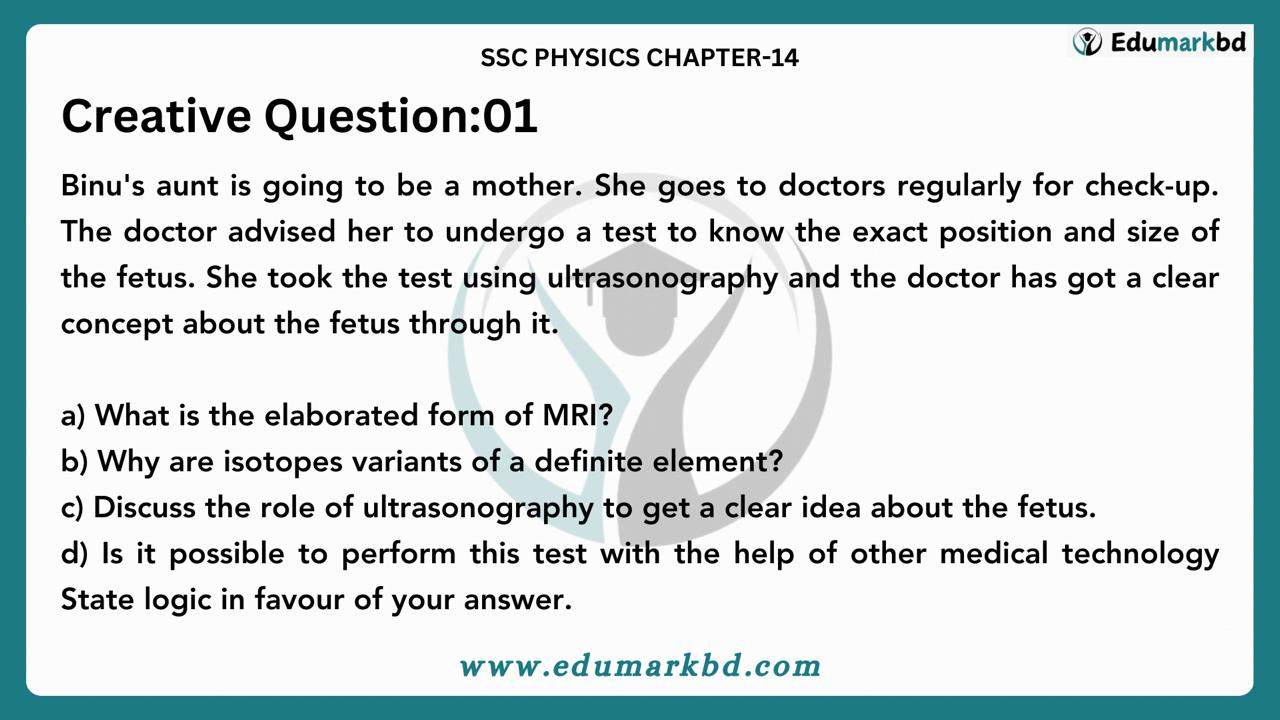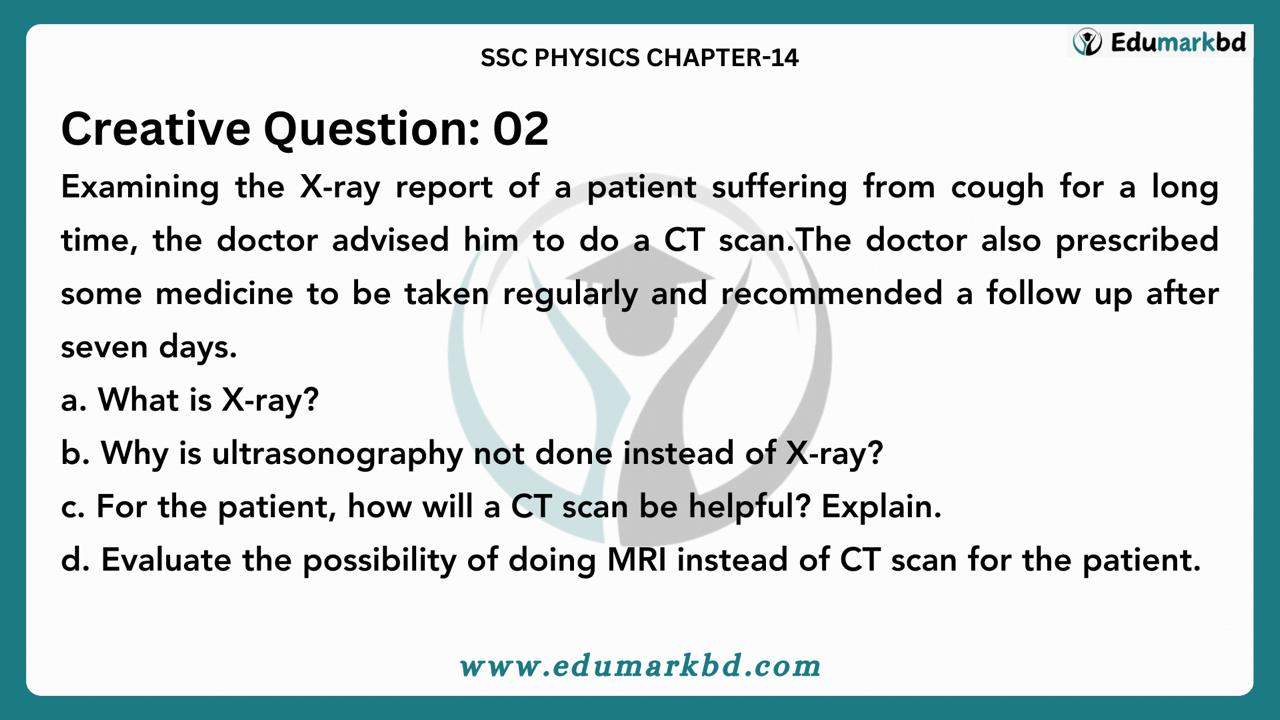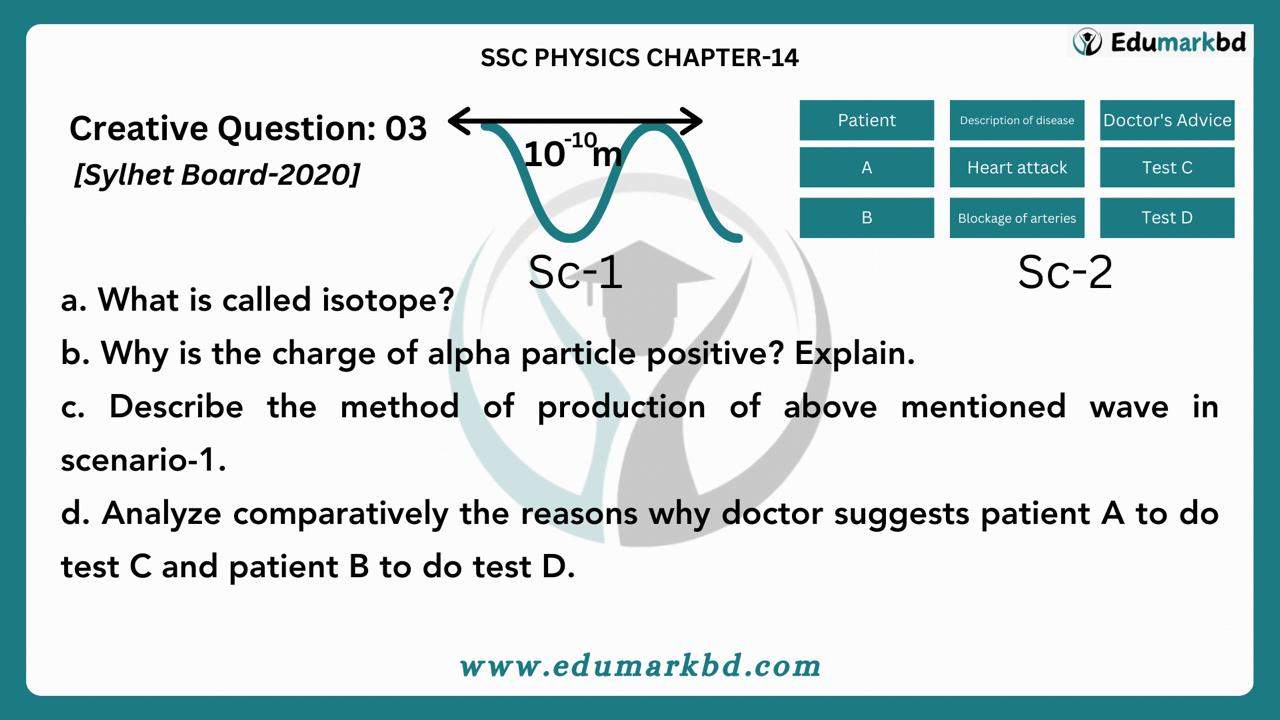SSC PHYSICS
Chapter Fourteen: Physics to Save Life
Short Questions and Answers:
Ques-1. What is called biophysics?
Ans: The new field of study that is created by establishing a relation between physics and biology is called biophysics.
Ques-2. What did Jagadish Chandra Bose establish to research about plant physiology?
Ans: Bose Biggan Mandir.
Ques-3. What is Cresco graph?
Ans: Cresco graph is a device that records the growth of plants.
Ques-4. Write the elaborated form of ECG.
Ans: The elaborated form of ECG is electrocardiogram.
Ques-5. What is angiography?
Ans: Angiography is such an imaging test where X-ray is used to view the blood vessels of the body. This test is used to study whether the arteries or veins are narrow, blocked or enlarged in the body.
Ques-6. What is called dye?
Ans: The liquid that is injected through the artery using a special narrow and flexible tube while performing an angiogram is called dye.
Ques-7. What is used in the MRI machine?
Ans: Strong magnetic field and radio wave is used in the MRI machine.
Ques-8. What is done to know whether the heart is working properly or not?
Ans: Painless diagnosis ECG or Electrocardiogram is done to know whether the heart is working properly or not.
Ques-9. What kind of sound wave is used in ultrasonography?
Ans: Ultrasonic sound wave is used in ultrasonography.
Ques-10. What is called echocardiography?
Ans: When ultrasound is used to examine the heart, that diagnostic procedure is called echocardiography.
Ques-11. What is X-ray?
Ans: The ray of high energy and small wavelength that pierces through the muscles and creates an image on a photographic plate is called X-ray.
Ques-12. Write the full form of CT Scan.
Ans: The full form of CT Scan is a Computed Tomography Scan.
Ques-13. What is a catheter?
Ans: During an angiogram; the thin and flexible tube that is entered into the patient’s body to inject a liquid dye is called a catheter.
Ques-14. Which scientific law is used in endoscopy?
Ans: The law of total internal reflection of light is used in endoscopy.
Ques-15. Write the elaborated form of PET.
Ans: The elaborated form of PET is Positron Emission Tomography.
Ques-16. What is an isotope?
Ans: If two atoms of the same element have the same number of protons but different numbers of neutrons then they are called isotopes of each other.
Ques-17. What is Brachytherapy?
Ans: The process of using radioactive phosphorus in liquid form in the treatment of blood cancer, radioactive strontium in bone cancer, and radioactive iodine in thyroid cancer is called Brachytherapy.
Ques-18. What is Radiotherapy?
Ans: Radiotherapy is the use of ion-generating (radioactive) radiation in the treatment of some diseases.
Ques-1. What is ultrasonography? Explain.
Ans: Ultrasonography is a procedure that depends on the reflection of sound of high frequency. When a sound wave of high frequency is reflected from an organ or muscle within the body, then an image analogous to that organ is formed in the monitor by the reflected waves.
Ques-2. Differentiate between X-ray and visible light.
Ans: X-ray is a kind of electromagnetic radiation. The wavelength of X-ray is much less than that of ordinary light. Its wavelength is about 10-10 m. The power of X-ray to penetrate any material becomes more as its wavelength gets smaller. For this reason, If an opaque medium is placed in the path of ordinary light, it cannot penetrate the medium. On the other hand, X-ray has high penetrating power. Ordinary light is visible and divided into different colors, but X-ray is invisible.
Ques-3. In Radiotherapy, how is the DNA of the cancer cells destroyed?
Ans: The DNA of cancer cell are destroyed in Radiotherapy by the two energies mentioned below-
i. Photon particles of light ray
ii. Radioactive particles
Ques-4. In which sectors radioactive isotopes are used?
Ans: In medical science, radioactive isotopes are widely used in nuclear medicine. Besides these, radioisotopes are widely used in the fields of agriculture, food preservation, controlling pests, and industries.
Ques-5. Why dye is used in angiography?
Ans: Angiography is used to see the blood vessels of the body using an X-ray. As blood vessels can’t be seen properly by doing a normal X-ray, a special contrast material is entered into the vessels. A catheter is entered into the body to inject dye at the part of the vessel that needs to be examined. After injected dye to a specific part of the blood vessel by catheter, an X-ray image of the part is taken. Due to the presence of the dye, the blood vessels can be seen clearly in an X-ray. The dye is later filtered by the kidney and passes out of the body by urine.

a) Answer: The elaborated form of MRI is Magnetic Resonance imaging.
b) Answer: The atoms of the same element having different mass numbers without any change in their atomic number are called isotopes.
This is the way they are the variants of a definite particle. The change does not take place either in the number of electrons or of protons but of neutrons; as a consequence the mass number differs in case of different atoms.
c) Answer: Updating…
d) Answer: Yes, it is possible to perform this test with two other diagnostic devices although one of them is not usually suggested.
Other than ultrasonography, CT scan and MRI are used for having three-dimensional images of the internal organs of human body. However, since CT Scan is prone to allergic reaction due to the use of dye, it is not suggested during pregnancy.
MRI (Magnetic Resonance Imaging) is the appropriate alternative to ultrasonography in this regard. It is safe on the ground that no radioactive ray (or even X-ray) is used in this device. MRI acts on magnetic field and radio wave neither of which carries any adverse effect on either the fetus or the woman going to give birth to a baby. It is a painless test which is widely used in imaging any organ of the body, even the brain.


